

 +1Kontinente:EU
+1Kontinente:EU2. Diagnose
2.1. Männchen
4. Weitere Informationen
4.1. Etymologie (Namenserklärung)
Tabell et al. (2025: 53) erklären: "The specific name refers to the collecting locality of the holotype."
4.2. Taxonomie
Tabell et al. (2025) diskutieren die bisher 7 aus Spanien (inkl. Balearen und Kanaren) bekannten Pleurota-Arten und ergänzen sie um gleich 6 neu beschriebene Arten. P. rondaensis fällt bei den Faltern mit einfarbig braunen Vorderflügeln beim Vergleich mit ähnlich aussehenden Taxa durch die Größe auf. Weiter hilft der Blick in die Genitalien. Die Autoren erklären zur Genetik von P. rondaensis: "Molecular data: Two specimens of P. rondaensis were sequenced successfully, resulting in 599 and 614 bp barcode fragments. The nearest neighbours to P. rondaensis are P. pyrenaella, P. hebetella and P. amaurodoxa, with 3.49 %, 4.15 % and 4.57 % divergences, respectively. The barcodes of P.rondaensis exhibit no intraspecific variation."
4.3. Faunistik
Tabell et al. (2025: 53) schreiben knapp: "Known only in southern Spain." Ihr Typenmaterial stammt komplett aus Málaga, und dort aus der weiteren Umgebung von Ronda.
4.4. Typenmaterial
Tabell et al. (2025: 52) erklären: "Type material: Holotype ♂ (DNA sample 24689 Lepid Phyl [barcoding failed]): SPAIN, Málaga, 20 km NE Ronda, 10-IV-2002, T. & K. Nupponen leg. (coll. NUP). Paratypes: 25 ♂ (GP 5581 J. Tabell, DNA sample 24688 Lepid Phyl), 3 ♀, same collecting data as holotype; 5 ♂, same collecting data, but 2-IV-1998, T. Nupponen leg.; 18 ♂, 2 ♀ (GP 5990 J. Tabell; DNA sample 24690 Lepid Phyl), same collecting data, but 9-IV-2002, T. & K. Nupponen leg. (colls. NUP and TAB, 2 exx. coll. MNCN); 1 ♂, Spain, Málaga, Ronda, 24-V-1989, H. Holmberg leg. (coll. NUP)."
(Autor: Erwin Rennwald)
4.5. Literatur
- Erstbeschreibung: Tabell, J., Honey, M., Leger, T., Mutanen, M., Nupponen, T. & P. Sihvonen (2025): New and poorly known Pleurota Hübner, [1825] species from peninsular Spain, the Balearic Islands, and the Canary Islands (Lepidoptera: Oecophoridae, Pleurotinae). — SHILAP Revista de lepidopterología, 53 (209): 43-74. [zum PDF-Download auf shilap.org]





